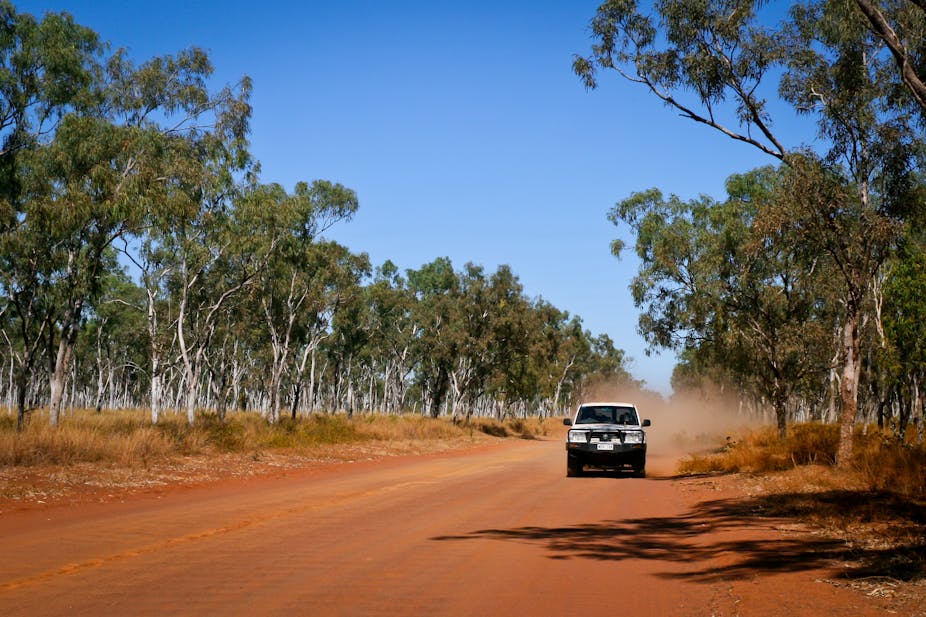Tony Abbott spent most of this week in North East Arnhem Land, part of his long-held hope “to be not just the Prime Minister but the Prime Minister for Aboriginal Affairs”. We asked our experts: what stories does the PM need to hear?
Getting a licence and driving a car is something many of us take for granted. But for Aboriginal and Torres Strait Islander people in some parts of Australia, getting a driver licence can be a major challenge. And breaching the conditions or simply failing to pay fines can result in licence suspension or even jail time.
More than 70% of Aboriginal and Torres Strait Islander people living in remote locations have no public transport. And more than one in ten Aboriginal and Torres Strait Islander Australian adults report not being able to, or often having difficulty, getting where they need to be.
Yet access to transport is essential for employment. Transport also provides the means to access education, health care and other essential services, as well as important social interactions.
Barriers to licensing
High crash and fatality rates among young people have led to the development of graduated licensing laws for new drivers.
But while the laws improve safety and are successfully driving crash rates down, they also create significant barriers to licensing. New drivers must pass multiple tests and accumulate up to 120 hours of supervised driving practice during the learner phase.
These laws have a disproportionate impact on Aboriginal people, who can face a number of barriers to getting a driver licence, including difficulty accessing identification documents, low levels of literacy and numeracy, the various costs associated with the graduated licensing system, lack of access to a car and a supervising driver, as well as outstanding debt.

In New South Wales, Aboriginal people are more likely to fail the driver knowledge test than non-Aboriginal people. And they are three times as likely to lose their driver licence due to fine default.
Although data are scarce in most states, driver licensing rates are low: Aboriginal people represent only 0.4% of all driver licence holders in NSW but make up 1.9% of the eligible driver population.
Imprisonment for driving offences
Driving without a licence can quickly lead to jail, and Aboriginal people are over-represented in driver licensing-related incarceration. In New South Wales, Aboriginal people found guilty of a “driver licence” offence are imprisoned at two to three times the rate for non-Aboriginal people.
It has been suggested that this is due to fines issued to unemployed people who are unable to pay them, and that such sentencing is unduly harsh, and out of line with community expectations.
The NSW coroner last week ruled on the death of an Aboriginal man in custody who was imprisoned for licensing offences. The coroner found he died of natural causes, but suggested it was understandable that the man would drive while unlicensed due to the long period of disqualification and lack of alternative transport.
Driver licences can also be cancelled due to other, non road-related fines, such as not having a train ticket, or having an unregistered dog. These fines can quickly accumulate and, if unpaid, can lead to the cancellation of the driver licence.
The solutions
There are a number of initiatives aimed at helping people with unpaid debt and others that assist people through the licensing process. In NSW, for instance, the Office of State Revenue has instituted work and development orders that allow eligible clients to reduce their fines via unpaid work.
Other programs exist to support Aboriginal people through the licensing process. These include the Northern Territory’s DriveSafe remote driver licensing program and the Queensland government’s Indigenous Driver Licensing Program. These state government programs deliver licensing and registry services but do not address debt management.
In NSW, licensing programs for Aboriginal people include community-based services delivered by Birrang enterprises and Ace Community Colleges. These programs deliver real benefits to their communities in terms of licences and employment outcomes.
Our team is currently implementing and evaluating Driving Change, a community-based Aboriginal driver licensing support program, across 12 sites in NSW. This end-to-end program delivers a range of services, from assistance with identification documents, to debt management and learner driver mentor services.
But while end-to-end licensing programs deliver the most significant benefits to individuals and communities, they are also the most costly to run, at A$2,500 to A$3,000 per completion. It’s therefore difficult to gain and maintain adequate funding.
A word about road safety
Licensing is critical for both mobility, education and employment. But maintaining safety on the road is equally important, especially considering Aboriginal people are killed at two to three times the rate of the rest of the population. Exempting Aboriginal people from the graduated licensing system is likely to increase their risk of crash and is therefore not a viable option.
We need greater investment in end-to-end licensing support programs for Aboriginal and Torres Strait Islander people, allowing people to more readily gain, and retain their driver licence. This has the potential to deliver real, tangible outcomes in terms of licensing, jobs and reduced incarceration, as well as a focus on safety.
Further reading in this Abbott in Arnhem Land series:
Birthing on Country could deliver healthier babies and communities
Welcome to my Country: seeing the true beauty of life in Bawaka
‘PM for Aboriginal Affairs’ Abbott faces his biggest hearing test
Australia’s 7 Up: the revealing study tracking babies to adults
Well-connected Indigenous kids keen to tap new ways to save lives
Indigenous Australia’s rapid rise is shifting money and votes
How crowded homes can lead to empty schools in the bush
Would you risk losing your home for a few weeks of work?
Listen to your elders: inviting Aboriginal parents back to school
Keeping Indigenous teens in school by reinventing the lessons
Explainer: Can a DNA test reveal if you’re an Indigenous Australian?
Explainer: what Indigenous constitutional recognition means

